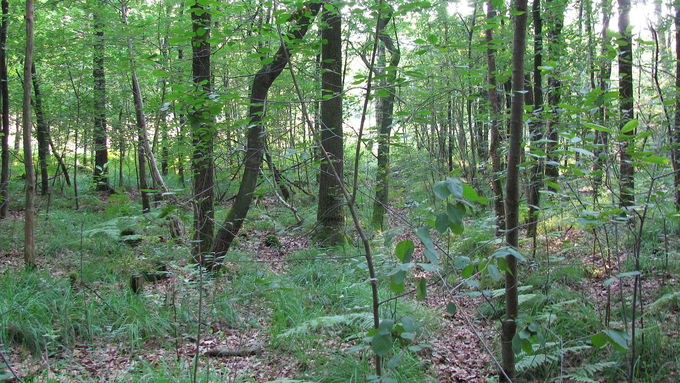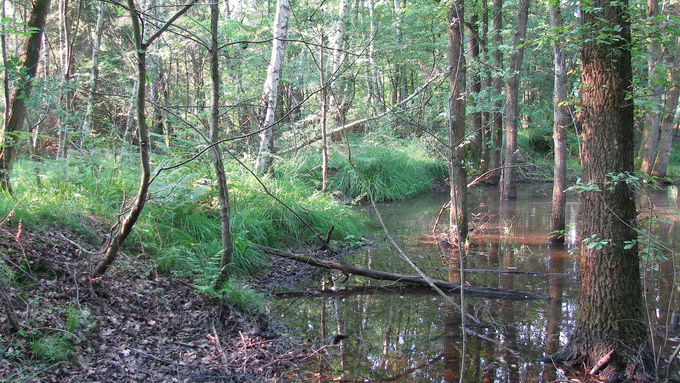A dense stand of trees characterized the area before the action started © Jan-Valentin Wiesmeyer, Landesbetrieb Wald und Holz NRW
main content
Project of the month
#1/2021 REACTIVATION OF HISTORIC PONDS AND HEATH MOORS
Restoration of habitat types 3130, 4010 and 7140 in the Lohmar Forest
The Lohmar Forest, which covers around 650 hectares between the towns of Lohmar and Siegburg, represents the southernmost part of the physical region ‘Bergische Heideterrasse’. The area is a popular local recreation area. With the Stallberg ponds in the nature reserve ‘Gagelbestand’ (NSG SU-004), one of the two historic fish farming sites in North Rhine-Westphalia which are still (partially) in use is located there. It is one of the largest heath moor and wet heath areas in the entire southern Rhineland. Heath moors, marshland forests, swamps, sandy dry grasslands and stream valleys with willows make the Lohmar Forest a habitat of statewide importance for many endangered species such as oblong-leaved sundew (Drosera intermedia), royal fern (Osmunda regalis) and bog-myrtle (Myrica gale). The Lohmar Forest is one of the most important sites in North Rhine-Westphalia for marsh St. John's wort (Hypericum elodes), ovate spikerush (Eleocharis ovata), rice cutgrass (Leersia oryzoides) and green-eyed hawker (Aeshna isoceles).
The historical use dating back to the Middle Ages still shapes the relief of the terrain today, even though a large part of the then intact ponds was destroyed in the 19th century by tearing down the pond embankment and resulting drainage. In addition, the standing water-bodies that had fallen dry were reforested in the 20th century. Due to the long drainage and overgrowing woody plants, the occurrences of rare species were only in a rudimentary state before the start of the action, and some of them were threatened with extinction.
The measures were carried out in cooperation with ‘Landesbetrieb Wald und Holz NRW’ which is also the landowner. Other participants were ‘Bündnis Heideterrasse’ which also offered several public excursions as part of the project implementation and the Lower Nature Conservation and Water Authority of the Rhine-Sieg District. In order to restore areas with wet heath and heather moors as well as nutrient-poor to moderately nutrient-rich standing waterbodies in the nature reserve ‘Gagelbestand’, the entire stock of trees and shrubs was first removed. To create transitional areas, the remaining area was heavily thinned out by removing previously marked woody plants. As the terrain was accessible to machines only to a very limited extent, horses were used for this work.
In a second step, the breaches at the former pond embankment then had to be sealed or repaired. Wooden stranded mats, held in place by false acacia poles, were mounted in a predominantly manual process. Clay or loess loam was placed between two such stranded mats to seal the dam. Thereby, the water now is retained in the area for longer.
As there are still intact, though rather small-scale remnants of the target habitats (habitat types 3130, 4010 and 7140) in the immediate vicinity of the worked area, there are optimal conditions for the resettlement of endangered and protected plant and animal species. The populations of the crested newt (Triturus cristatus) and the yellow-spotted whiteface (Leucorrhinia pectoralis) can thus be stabilised and their aquatic and terrestrial habitats improved and expanded.
Related topics
Further links
- Nature reserve ‘Gagelbestand’ – Landesamt für Natur und Umweltschutz (in German) (external link opens in a new window)
- Landesbetrieb Wald und Holz NRW (in German) (external link opens in a new window)
- Bündnis Heideterrasse (in German) (external link opens in a new window)
- District Rhein-Sieg – Department for Nature Conservation and Landscape Protection (in German) (external link opens in a new window)





